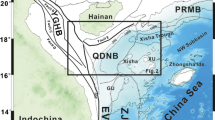Abstract
We study mass wasting along the Middle America Trench (MAT), a subduction zone dominated by tectonic erosion, using a comprehensive data set of seafloor relief. We integrate previous studies of long-term tectonic processes to analyze how they influence the evolution of the slope structure and precondition the continental slope for mass wasting. We have used the distribution of an inventory of 147 slope failure structures along the MAT to discuss their relation to subduction erosion. We interpret that preconditioning of the slope by long-term tectonics, interacts in a shorter-term scale with features on the under-thrusting oceanic plate to modulate the abundance and types of mass wasting phenomena. The complex origin of the incoming oceanic plate has produced abrupt lateral changes in plate age, crustal thickness, relief, and response to bending deformation at the trench, leading to its partitioning into six segments. We found that the continental-slope failure style and abundance are partitioned into six segments that spatially match the ocean plate segments.
Access this chapter
Tax calculation will be finalised at checkout
Purchases are for personal use only
Similar content being viewed by others
References
Barckhausen GA, Ranero CR, von Huene R, Cande S, Roeser H (2001) Revised tectonic boundaries in the Cocos Plate off Costa Rica: implications for the segmentation of the convergent margin and for plate tectonic models. J Geophys Res 106:19207–19220
DeMets C (2001) A new estimate for present-day Cocos-Caribbean plate motion: implications for slip along the central American volcanic arc. Geophys Res Lett 28:4043–4046
Harders R, Kutterolf S, Hensen C, Moerz T, Brueckmann W (2010) Tephra layers: a controlling factor on submarine translational sliding? Geochem Geophys Geosyst 11:Q05S23. doi: 10.1029/2009GC002844
Harders R, Ranero CR, Weinrebe, W, Behrmann, JH (2011) Submarine slope failure along the convergent continental margin of the Middle America Trench. Geochem Geophys Geochsyst 12: Q05S32, doi:10.1029/2010GC003401
Hühnerbach V, Masson DG, Bohrmann G, Bull JM, Weinrebe W (2005) Deformation and submarine landsliding caused by seamount subduction beneath the Costa Rica continental margin – new insights from high-resolution sidescan sonar data. In: Hodgons DM, Flint SS (eds) Submarine slope systems: processes and products, Geological Society Special Publications 244. The Geological Society, Bath, pp 195–205
Kukowski N, Greinert J, Henrys S (2010) Morphometric and critical taper analysis of the Rock Garden region, Hikurangi Margin, New Zealand: implications for slope stability and potential tsunami generation. Mar Geol 272:141–153. doi: 10.1016/j.margeo.2009.06.004, 0025-3227
McAdoo BG, Pratson LF, Orange DL (2000) Submarine landslide geomorphology, US continental slope. Mar Geol 169:103–136
McIntosh KD, Silver EA, Ahmed I, Berhorst A, Ranero CR, Kelly RK, Flueh ER (2007) The Nicaragua convergent margin: seismic reflection imaging of the source of a tsunami earthquake, Rica. In: Dixon T, Moore JC (eds) The seismogenic zone of subduction thrust faults. Columbia University Press, New York, pp 257–287
Ranero, CR, von Huene R, Flueh E, Duarte M, Baca D, and McIntosh K (2000) A cross section of the convergent Pacific margin of Nicaragua. Tectonics 19 (2): 335–357. doi:10.1029/1999TC900045
Ranero CR, Villaseñor A, Phipps Morgan J, Weinrebe W, (2005) Relationship between bend-faulting at trenches and interslab seismicity. Geochem Geophys Geosyst 6: Q12002. doi:10.1029/2005GC000997
Ranero CR, Grevemeyer I, Sahling H, Barckhausen U, Hensen C, Wallmann K, Weinrebe W, Vannucchi P, von Huene R, McIntosh K (2008) The hydrogeological system of erosional convergent margins and its influence on tectonics and interplate seismogenesis. Geochem Geophys Geosyst 9:Q03S04. doi: 10.1029/2007GC001679
von Huene R, Bourgois J, Miller J, Pautot G (1989) A large tsunamogenic landslide and debris flow along the Peru Trench. J Geophys Res 94:1703–1714
von Huene R, Ranero CR, Weinrebe W and Hinz K (2000) Quaternary convergent margin tectonics of Costa Rica, segmentation of the Cocos Plate, and Central American volcanism. Tectonics 19:314–334. doi:10.1029/1999TC001143
von Huene R, Ranero CR, Watts P (2004a) Tsunamigenic slope failure along the Middle America Trench in two tectonic settings. Mar Geol 203:303–317
von Huene R, Ranero CR, Vannucchi P (2004b) A model for subduction erosion. Geology 32:913. doi: 10.1130/G20563.1
Acknowledgements
This publication is contribution no. 210 of the Sonderforschungsbereich 574 “Volatiles and Fluids in Subduction Zones” at Kiel University funded by Deutsche Forschungsgemeinschaft (DFG). The data were collected during cruises of German R/V Sonne funded by the Ministry of Science and Education (BMBF) and R/V Meteor the Deutsche Forschungsgemeinschaft (DFG), and US R/V Ewing funded by NSF. We acknowledge the reviews of J. Chaytor and R. von Huene that helped improve the clarity of the paper.
Author information
Authors and Affiliations
Corresponding author
Editor information
Editors and Affiliations
Rights and permissions
Copyright information
© 2012 Springer Science+Business Media B.V.
About this paper
Cite this paper
Harders, R., Ranero, C.R., Weinrebe, W. (2012). An Overview of the Role of Long-Term Tectonics and Incoming Plate Structure on Segmentation of Submarine Mass Wasting Phenomena Along the Middle America Trench. In: Yamada, Y., et al. Submarine Mass Movements and Their Consequences. Advances in Natural and Technological Hazards Research, vol 31. Springer, Dordrecht. https://doi.org/10.1007/978-94-007-2162-3_35
Download citation
DOI: https://doi.org/10.1007/978-94-007-2162-3_35
Published:
Publisher Name: Springer, Dordrecht
Print ISBN: 978-94-007-2161-6
Online ISBN: 978-94-007-2162-3
eBook Packages: Earth and Environmental ScienceEarth and Environmental Science (R0)




